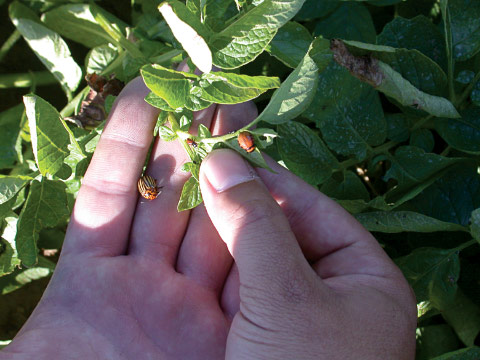Resistance Is Futile
…Or at Least Diminished, Thanks to Reduced-Area Treatments on Potatoes
 |
|
Colorado potato beetle infestations begin when the insects walk into potato fields in the spring from overwintering sites, entering from the perimeter. |
Potatoes are one of the most important crops in the Northeast, with more than 100,000 acres harvested and a value of nearly $270 million annually. Numerous insect pests threaten potato crops, the most notorious of which is the Colorado potato beetle (CPB).
Growers depend heavily on the insecticide imidacloprid to control CPB, but overreliance on a single type of insecticide is an unsustainable approach, as pests eventually develop an ability to tolerate the insecticide. This pesticide resistance can jeopardize growers' capacity to prevent damage.
University of Maine entomologist Andrei Alyokhin led a team of researchers who reduced the amount of imidacloprid used on potato crops, treating only selected areas on the perimeter of the field. The project, funded through a Northeast Regional IPM Competitive Grant, also involved use of chemical substances called kairomones to attract the beetles and lure them to treated areas, thus increasing their exposure to toxins. Perimeter treatments allowed the team to control beetles successfully using less insecticide: CPB densities were 6–11 times lower in the treated perimeter areas than in untreated plots.
The reduced-area-treatment approach is very simple and requires no special skills or major changes to existing crop management practices, so it can be readily put to use by commercial growers. These treatments would allow growers to cut insecticide use on potato crops by at least 20 percent while putting the brakes on resistance development in CPB populations.
After receiving this grant, Alyokhin was awarded an EPA Pesticide Environmental Stewardship Grant to promote use of this technology.
— by ELIZABETH MYERS
The Northeastern IPM Center promotes integrated pest management for reducing risks to human health and the environment. If republishing our news, please acknowledge the source (“From Northeast IPM Insights”) along with a link to our website.
